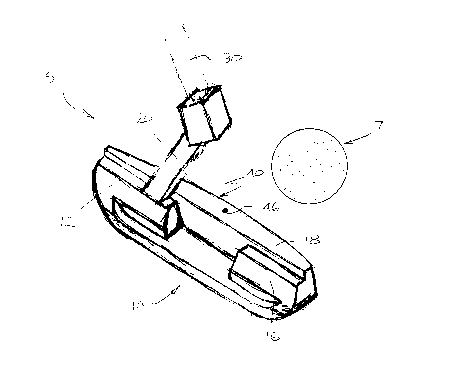Some of the information on this Web page has been provided by external sources. The Government of Canada is not responsible for the accuracy, reliability or currency of the information supplied by external sources. Users wishing to rely upon this information should consult directly with the source of the information. Content provided by external sources is not subject to official languages, privacy and accessibility requirements.
Any discrepancies in the text and image of the Claims and Abstract are due to differing posting times. Text of the Claims and Abstract are posted:
| (12) Patent Application: | (11) CA 2215689 |
|---|---|
| (54) English Title: | PUTTER WITH CONVEX STRIKING SURFACE |
| (54) French Title: | FER DROIT AVEC SURFACE DE FRAPPE CONVEXE |
| Status: | Deemed Abandoned and Beyond the Period of Reinstatement - Pending Response to Notice of Disregarded Communication |
| (51) International Patent Classification (IPC): |
|
|---|---|
| (72) Inventors : |
|
| (73) Owners : |
|
| (71) Applicants : |
|
| (74) Agent: | |
| (74) Associate agent: | |
| (45) Issued: | |
| (22) Filed Date: | 1997-09-16 |
| (41) Open to Public Inspection: | 1999-03-16 |
| Availability of licence: | N/A |
| Dedicated to the Public: | N/A |
| (25) Language of filing: | English |
| Patent Cooperation Treaty (PCT): | No |
|---|
| (30) Application Priority Data: | None |
|---|
A golf putter for striking a golf ball on a putting surface has an elongate
shaft with
a top end for gripping by a user, and a putter head at the opposed bottom end
with a front
face for striking the golf ball. The front face has a convex horizontal
curvature and a flat
vertical profile so that the golf ball is urged to travel in a desired
direction and so that a
forward roll is imparted thereon with minimal skidding of the golf ball on the
putting
surface. The putter head's top surface has a marker for aligning the golf ball
with the front
face. The marker is located at the apex of the convex horizontal curvature and
aligned
with the longitudinal axis of the shaft so that the golf ball travels in the
desired direction
even if the putter head is twisted slightly upon striking the golf ball.
Note: Claims are shown in the official language in which they were submitted.
Note: Descriptions are shown in the official language in which they were submitted.

2024-08-01:As part of the Next Generation Patents (NGP) transition, the Canadian Patents Database (CPD) now contains a more detailed Event History, which replicates the Event Log of our new back-office solution.
Please note that "Inactive:" events refers to events no longer in use in our new back-office solution.
For a clearer understanding of the status of the application/patent presented on this page, the site Disclaimer , as well as the definitions for Patent , Event History , Maintenance Fee and Payment History should be consulted.
| Description | Date |
|---|---|
| Revocation of Agent Requirements Determined Compliant | 2022-04-01 |
| Inactive: IPC deactivated | 2015-03-14 |
| Inactive: First IPC from PCS | 2015-01-17 |
| Inactive: IPC from PCS | 2015-01-17 |
| Inactive: IPC expired | 2015-01-01 |
| Time Limit for Reversal Expired | 2000-09-18 |
| Application Not Reinstated by Deadline | 2000-09-18 |
| Inactive: Cover page published | 1999-10-15 |
| Deemed Abandoned - Failure to Respond to Maintenance Fee Notice | 1999-09-16 |
| Application Published (Open to Public Inspection) | 1999-03-16 |
| Inactive: Correspondence - Formalities | 1998-10-13 |
| Inactive: IPC assigned | 1997-12-10 |
| Classification Modified | 1997-12-10 |
| Inactive: First IPC assigned | 1997-12-10 |
| Inactive: Filing certificate - No RFE (English) | 1997-11-21 |
| Filing Requirements Determined Compliant | 1997-11-21 |
| Application Received - Regular National | 1997-11-20 |
| Abandonment Date | Reason | Reinstatement Date |
|---|---|---|
| 1999-09-16 |
| Fee Type | Anniversary Year | Due Date | Paid Date |
|---|---|---|---|
| Application fee - small | 1997-09-16 |
Note: Records showing the ownership history in alphabetical order.
| Current Owners on Record |
|---|
| GEORGE KARPUK |
| Past Owners on Record |
|---|
| None |